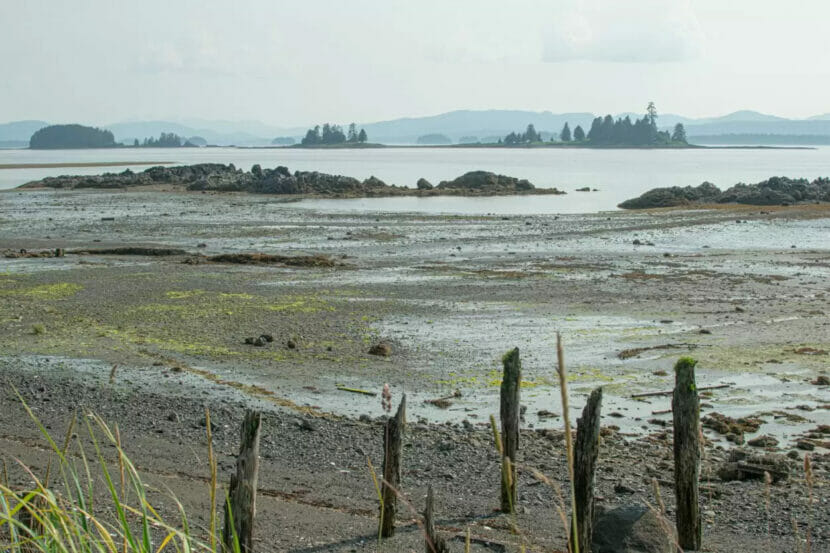
The Organized Village of Kake laid the foundation for Alaska’s first modern clam garden in early August. The Southeast Alaska community hopes the project will preserve an important food source and keep traditional knowledge alive.
A group of eight Kake community members got up at the crack of dawn to beat the tide. They needed to pile a line of stones 60 feet long on the village’s shoreline. They’ll slowly add to it over the course of the summer until it’s about two feet high. That wall, they hope, will eventually house thousands of clams and cockles.
Aiden Clark is a junior at Kake High School, and a member of the Alaska Youth Steward Program. He was all in to spend a morning out of his summer vacation hauling around big rocks for the clam garden.
“It’s a lot of rock to move, but it’ll do good for the community,” Clark said. “The clam population is starting to go down a lot.”
The Environmental Protection Agency projects that shellfish harvests across the U.S. could fall by nearly a half by the end of the century. The administration said human-caused climate change is the culprit: warming waters are inviting predators into bivalve habitat, and that ocean acidification is dissolving their delicate shells.
Simon Friday is the natural resources coordinator for the Organized Village of Kake, the village’s tribal government. Friday said the garden will help make local shellfish more resilient to climate change in three ways. The first: by helping them weather the storms that tend to tear up the coastline.
“So, shellfish gardens provide protection to the beach from erosion due to storms,” Friday said. “That’s something that’s likely to occur [more frequently] with climate change.”
The second reason: clam gardens increase the number of shell fragments in the area, boosting the minerals baby clams need to create their shells.
“We’re hoping that will help out with the ocean acidification, due to the calcium in the shells,” he said.
And the third reason: the rock fortress could help trap food for the clams.
“The gardens change the drainage of the beach, which allows more phytoplankton to be readily available,” he said. “So they have more food to eat, which allows them to grow faster and stronger and bigger — and all that good stuff.”
However, Friday said Kake’s clam garden isn’t just for the benefit of local marine life. During the COVID-19 pandemic, shipments of food weren’t coming in on time, and the shelves of the village’s only grocery store were laid bare. Now that things have settled down, Kake is preparing for the next crisis.
“We also realized that with climate change that we needed some sort of localized protective measures, to ensure that we continue to have the foods that we enjoy,” Friday said. “One of those being: clams.”
They’re also hoping it’ll help fix the limited and expensive food options available to them right now. Eloise Peabbles manages the Alaska Youth Steward Program in Kake, and she’s helping rally youth volunteers to move boulders for the garden. Supporting local food security is a huge priority for her.
“[And that’s] particularly because of the fact that we are already limited in our food — by having a small grocery store, and then having those prices be extremely expensive,” said Peabbles. “In order to have a healthy diet, we need to rely on the land and water around us.”
For thousands of years, many Indigenous communities up and down the Pacific Coast gardened shellfish. Over time, their practices not only increased shellfish production, but also expanded their habitat and improved species diversity according to a study of ancient clam gardens from Simon Fraser University.
The Swinomish Indian Tribal Community of Washington State built the very first modern clam garden in the United States last year. Friday visited it a few times to learn from the garden-builders and help with some construction tasks. Now, he’s thrilled to see his community invested in building a shellfish garden of their own.
“You’re literally just moving heavy rocks,” Friday said. “You need as many hands on deck as possible. So when it comes to constructing these gardens, it’s a community event. It just requires a lot of work — and a lot, a lot of people to move rock.”
With the foundation laid out, the last thing left for them to do is stack it all the way up to two feet. Friday said the main point of the exercise is education. So the bivalves that do take up root in the garden are just a bonus.




